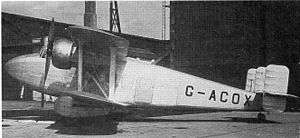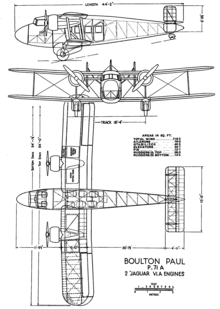Boulton Paul P.71A
The Boulton & Paul P.71A was a 1930s British twin-engined all-metal biplane transport aircraft developed by Boulton & Paul Ltd from the unsuccessful P.64 Mailplane to meet an Imperial Airways requirement for a mail plane.
| P.71A | |
|---|---|
 | |
| Boulton-Paul P.71A G-ACOX Boadicea | |
| Role | Mail plane/Light Transport |
| Manufacturer | Boulton & Paul Ltd |
| Introduction | 1935 |
| Retired | 1936 |
| Status | Destroyed |
| Primary user | Imperial Airways |
| Number built | 2 |
| Developed from | Boulton Paul P.64 Mailplane |
History
The P.71A was the successor to the Boulton & Paul's first attempt to meet the airline requirement, the P.64 Mailplane. The P.71A was lighter, slimmer and longer and used Armstrong Siddeley Jaguar IVA radial piston engines.
Two aircraft were built and delivered to Imperial Airways at Croydon Airport in February 1935. The airline had lost interest in using them as mailplanes, so the two aircraft were converted as VIP transports with 13 removable seats.
G-ACOX
The first aircraft, registered G-ACOX and named Boadicea after the Briton queen of that name, was lost in the English Channel on 25 September 1936 while on an air-mail flight from Croydon to Paris with the loss of the two crew.
G-ACOY
The second aircraft, registered G-ACOY and named Britomart after the literary character of that name, was damaged beyond repair in a landing accident at Haren, Brussels on 25 October 1935.
Specifications

Data from Imperial Airway's Latest [1]
General characteristics
- Crew: 2
- Capacity: 6–7 passengers[2]
- Length: 44 ft 2 in (13.46 m)
- Wingspan: 54 ft 0 in (16.46 m)
- Height: 15 ft 2 1⁄4 in (4.629 m)
- Wing area: 718.5 sq ft (66.75 m2)
- Aspect ratio: 7.91:1
- Empty weight: 6,100 lb (2,767 kg)
- Gross weight: 9,500 lb (4,309 kg)
- Fuel capacity: 186 imp gal (223 US gal; 850 L)
- Powerplant: 2 × Armstrong Siddeley Jaguar VIA 14-cylinder radial engines, 490 hp (370 kW) each
Performance
- Maximum speed: 195 mph (314 km/h, 169 kn) [3]
- Cruise speed: 150 mph (240 km/h, 130 kn) at 4,500 ft (1,400 m)
- Range: 600 mi (970 km, 520 nmi) (full tanks)
- Service ceiling: 21,000 ft (6,400 m)
- Rate of climb: 1,400 ft/min (7.1 m/s)
- Time to altitude: 4.5 min to 4,500 ft (1,400 m)
References
- Notes
- Flight 31 January 1935, p.118.
- Flight 31 January 1935, p.123.
- Donald 1997, p.178.
- Bibliography
- Donald, David, ed. (1997). The Encyclopedia of World Aircraft. Leicester, UK: Blitz Editions. ISBN 1-85605-375-X.
- The Illustrated Encyclopedia of Aircraft (Part Work 1982–1985). Orbis Publishing.
- "Imperial Airways' Latest". Flight. Vol. XXVII no. 1362. 31 January 1935. pp. 118–123.
- Jackson, A.J. (1974). British Civil Aircraft since 1919. London: Putnam. ISBN 0-370-10014-X.
External links
| Wikimedia Commons has media related to Boulton & Paul P.71A. |
- Boulton & Paul P.71A – British Aircraft Directory